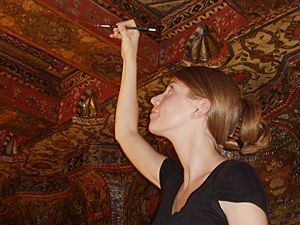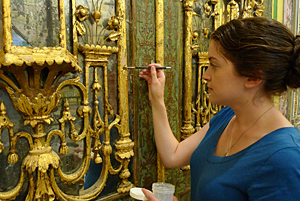
ADVERTISEMENT
- UD grad students help preserve cultural heritage across U.S., around globe
- LeeAnn Barnes Gordon: Agora Excavations, Athens, Greece
- Lauren Bradley: Walters Art Museum, Baltimore
- Alisha Chipman: Paul Messier, LLC
- Rose Daly: Nasher Sculpture Center, Dallas
- Emily MacDonald-Korth and Carlos Moya: Fengguo Temple, Yixian, China
- Amanda Maloney: C.C. von Waldthausen Fotorestauratie Atelier, Amsterdam
- Gwen Manthey: Western Center for the Conservation of Fine Arts, Denver
- Carrie Roberts: English Heritage, London
- Kirsten Travers: Stichting Restauratie Atelier Limburg, the Netherlands
- Renee Wolcott: Smithsonian National Portrait Gallery
- Erin A. Anderson: Poggio Colla, Mugello Valley of Tuscany
- Tatiana Cole: Metropolitan Museum of Art
- Anne Getts: Philadelphia Museum of Art
- Sarah Gowen and Stephanie Oman: Shangri La, Honolulu, Hawaii
- Allison Holcomb: Colonial Williamsburg, Williamsburg, Va.
- Ellen Moody: Sherman Fairchild Center, Metropolitan Museum of Art
- Steve O'Banion: Smithsonian American Art Museum, Lunder Conservation Center
- Ellen Promise: Philadelphia Museum of Art
12 p.m., July 28, 2010----Doris Duke, the famous heiress, developed a passion for Islamic art and architecture during a honeymoon trip around the world. One of her last stops was Honolulu, Hawaii, where she decided to design and construct a home inspired by the art she loved. She called it Shangri La, and later in life, decided that her house would become a public museum to showcase her collection of Islamic art.
The Winterthur/University of Delaware Program in Art Conservation (WUDPAC) has an ongoing relationship with the Doris Duke Foundation for Islamic Art to treat several of the historic interiors that have been reconstructed within Shangri La. We have had the wonderful opportunity to continue the treatment of some of Shangri La's most prized artifacts.
We began our project by continuing the work of last year's WUDPAC interns (Kirsten Travers and LeeAnn Barnes Gordon), who mapped the condition and began the treatment of an 18th-century decorative ceiling from Damascus, Syria. Doris Duke installed this ceiling in the late 1970s in what she called the Turkish Room. The most significant condition issues included flaking paint and visible losses to the decorative plaster, or adjami, that forms the embossed design.
In keeping with last year's treatment, we consolidated paint with BEVA gel and Aquazol 200 and 500. We in-painted significant losses with dry pigments in Aquazol 50, which is a water-soluble and easily reversible binding medium. Condition issues, treatment areas and materials used continued to be recorded and mapped with Adobe Illustrator software for future reference.
In addition to conserving the ceiling, we have been mapping and treating two gilded mirror doors with termite damage. Condition issues include major losses and paper-thin areas of wood, paint and gilding. To stabilize the doors, we have been consolidating loose elements with Rhoplex, an aqueous acrylic emulsion that was used in a previous restoration campaign. Additionally, we are filling areas of loss with Japanese tissue that will be coated with Rhoplex and toned for visual integration.
These projects have provided a variety of treatment experiences and the chance to spend the summer at an amazing institution in a veritable paradise. As a future painting major with a particular interest in panel paintings (Sarah) and as a future painted surfaces major with an interest in historic architecture (Stephanie), we've found that these projects have provided an ideal opportunity to gain hand skills with painted wooden surfaces.
We look forward to hearing the experiences of future WUDPAC students as they continue to conserve Shangri La's unique historic interiors.



